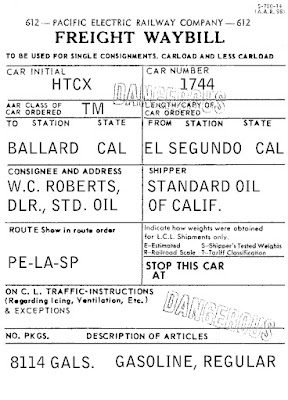By “grading,” I mean an inspector’s grade of the quality of a car’s interior, not grading of models in a contest, or photographs in a photo competition. This was done on the prototype to identify high-quality cars for loads that would require them, and low-quality ones for rough or contaminating cargoes (and avoiding the reverse). Few modelers (including me!) choose to incorporate this aspect into layout operating sessions, but it’s a visible part of prototype operation.
Included in the very interesting route card collection of Michael Litant are a number of cards obviously printed for use of car inspectors (I have used a number of Michael’s cards in my previous post, which can be found here: https://modelingthesp.blogspot.com/2023/07/route-cards-part-18-further-examples.html ).
I will begin with a very complete New York Central System card, defining all the usual four grades, as shown below. Grade A meant good-quality floor and lining, free from leaks, odor, oil spots and contamination (and as the card stages, “must not be used for lading that will contaminate”), and the example cargoes are cereal, grain, flour, bagged foods, and similar lading. Class B required a car free from leaks, with a fair floor and lining and unbowed end lining, thus suitable for cargoes like grain in bulk, plasterboard, paper, home appliances, tin cans, canned and bottled goods in cartons, and palletized items.
Class C only required a car free from leaks, and could be used for fertilizer, cement, plaster, steel, merchandise in cartons, crates, boxes and barrels, and contaminating chemicals. Class X (on the NYC; on many roads, Class D) was a car that was leaking or contaminated, to be used only for lading not subject to damage by water, cinders or contamination. This classification was also used for open-top cars, for which Class X quality was suitable for sand, gravel, coal, ore, steel, pipe, export boxes, trucks and tanks.
Like many railroads, the NYC prepared this card so it could be folded, and only the relevant part visible when stapled to a route or placard board. It was double-sided; I show below both sides. Unfolded, it is 4 x 6 inches. The written part is for Class B, and was stapled uppermost. It is stamped at Elkhart, Indiana, October 5, 1965.
A very similar arrangement of a double-sided grading card shown below is from the Louisville & Nashville. A 4 x 5-inch card, its attachment staple unfortunately was placed right in the number of the GN car, but it was given a Class A rating. It gives even more possible cargoes in classes B and C than does the New York central card above. It had not been folded.
And just to show one more example of this type of grading card, this one is from the Bangor & Aroostook, a 4 x 6-inch card intended to be folded. Interestingly, the “D” code was outward, and no car initial or number is written; instead, it merely says “bad floor walls & ends,” obviously the reason for the D grade.
Recently on TrainOrders.com a really interesting document was posted, a Milwaukee Road guide on grading cars. The Milwaukee system was like those above, grades A through E, except for grades A through D, a sub-grade of AX, BX, etc. was included. This meant the car could be, say, Grade A, if crews removed protruding nails, oil spots, etc. Thanks to Bob Chaparro for pointing me to this document. You can see it at: https://trainorders.us/cargrade/MilwGradeingAndInspectionCars1939.pdf .
I show an example of both sides of such a card, 3 x 4 inches, below, and
it’s interesting that the “X” is made more obvious with color. In this case, crews were directed to take action in preparing the car for loading if the “AX” side were displayed.
Finally, an interesting combination of two functions on the two sides of one card, 3.5 x 7.25 inches from the Southern Railway. One is the same grading categories, A, B and C, along with a category S for “special.” The other side directs the car to be light weighed. No car identification or location is shown on this card, and the dirtier, thus outward, side of the car is the weighing direction, so that must be how this one had been used.
Grading is certainly an interesting aspect of freight car handling (specifically, preparation for loading of empties), and something we could implement in layout operation in simplified form, especially if you model a yard with a variety of empties that can be used for particular industries. More on that later.
Tony Thompson










































